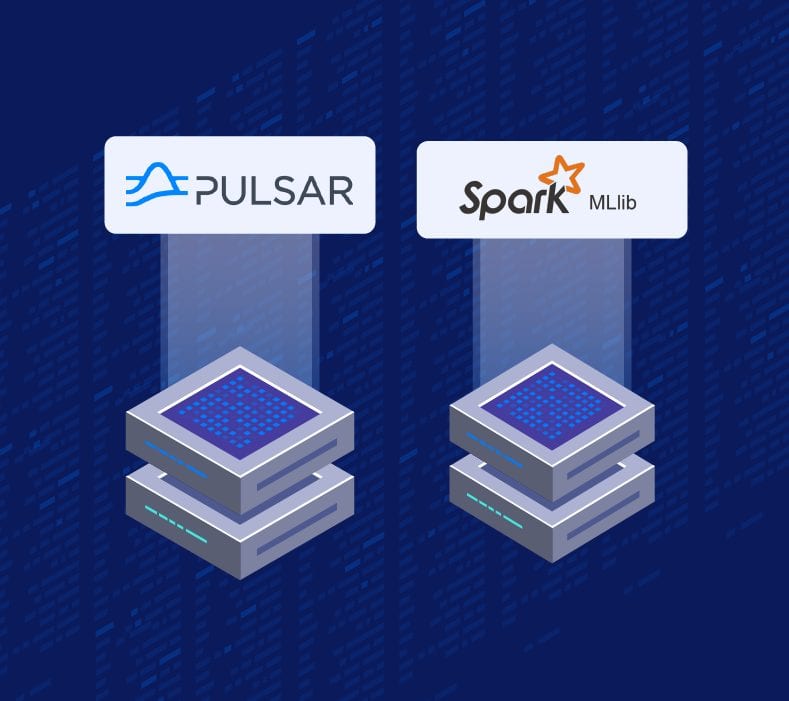Pulsar and Spark: The Future of Distributed Computing & AI
Artificial intelligence (AI) and machine learning (ML) offer many benefits to businesses across verticals. They can automate repetitive processes, enable people in key positions to make smart and data-driven decisions, and minimize operational costs. However, many of the available technologies come with several limitations and challenges.
For instance, AI and ML use multi-pass algorithms. The current models for distributed computing, such as MapReduce, are great at one-pass computations, but their efficiency significantly drops when used for AI and ML. Distributed computing had to turn to other solutions – distributed messaging and streaming platforms and analytics engines for big data.
Today we will take a closer look at one of the best distributed messaging platforms – Pulsar, and an analytics engine for big data – Spark.
Working Hand-in-hand to Enable AI
Using AI and ML efficiently comes with several challenges. The main one is efficient resource allocation. Storing and processing big data is not an easy task both from the software and infrastructure perspective. Also, the nature of the data is dynamic. You never know how much data you will have to process and store at a point. This is where scaling comes in as another issue.
Both Pulsar and Spark tackle these challenges efficiently. Let’s start with Pulsar. Pulsar is built to keep processing and storage as two separate entities. By doing it, Pulsar removes the problems related to scaling entirely out of the equation.
For instance, Pulsar doesn’t store data on the brokers. Instead, it keeps these layers separate. You can add additional brokers at any given time. Meanwhile, you don’t have to manage or re-partition the data. Add tiered storage to it, and you have a cost-efficiency monster solution. It automatically discards acknowledged data and retains the unacknowledged one, thus cutting down data storage costs.
Pulsar enables fast processing via customizable storage nods. For instance, the data that has to feed ML and AI algorithms can be stored on SSD-based storage for ultra-fast read-write speeds. You can also set the historical data to be stored on HDD-based storage.
Spark works great with Pulsar because it extends its functionality by bringing in the analytics engine for large-scale data processing. Spark uses a query optimizer, physical execution engine, and cutting edge DAG scheduler. The DAG scheduler has multiple stages that increase the efficiency of the distribution of jobs. It excels at multi-stage jobs particularly.
All of this enables it to deliver outstanding performance when working with either live streaming or batch data.
Spark also enables the making of parallel apps easily. It comes with many high-level operators that support Java, Python, SQL, Scala, and R. This also means that you can seamlessly use it with Pulsar. When it comes to ML and AI, Spark delivers MLib libraries developed explicitly for this use case. MLib is significantly faster than MapReduce, and it supports iterative computation.
The Common Use Cases
Pulsar and Spark have found use cases across verticals. They have resolved the major pain points in the insurance, automotive, and media industries.
Insurance
In insurance, Pulsar and Spark deliver exception security. They work hand in hand to prevent fraud. The system built on Pulsar and Spark has sophisticated intrusion detection capabilities. Insurance companies can use it to enable risk-free authentication.
Thanks to Pulsar and Spark, insurance companies can store and process vast amounts of archived logs. They can cross-reference logged data with information from external resources and compromised accounts to react in time and prevent intrusions and frauds.
Automotive
Modern cars produce significantly more data than their older counterparts. For insurance, new systems such as autonomous driving and advanced driver assistance systems can make up to 2 GB of data per second.
Pulsar and Spark can help the automotive industry record, store, and analyze the data. More importantly, the AI and ML can simulate the scenarios to alert the drivers and make corrections in time.
Media
Media entertainment giants use global data centers and have millions of clients across the world. They need a highly available system with low latency and the ability to down or up-scale on-demand, and Pulsar and Spark deliver all of it.
Thanks to Pulsar, companies can architect low latency data leaks and build a system capable of handling millions of write requests per second. With Spark streaming, the industry can optimize video streams and efficiently manage live video traffic.
Pulsar and Spark: Advantages and Challenges
Pulsar and Spark offer a great many perks to companies across verticals. While Spark enables analytics for big data, Pulsar is there to help them manage hundreds of billions of events per day. Combined, they resolve the scalability issues, reduce the operational costs, improve security and performance, and deliver exceptional customer experience.
On the other hand, to use Pulsar and Spark efficiently, you need to have sufficient technical knowledge, especially if you are transitioning from one system to another. The adoption challenges form the last barrier for distributed messaging and data analytics tools adoption. This is where Pandio comes in.
Pandio Unlock’s Pulsars Full Power
Pandio is a fully-managed Pulsar and Spark service. Pandio takes both Pulsar and Spark and delivers them on a brand new level. The company has integrated a neural network into Apache Pulsar to achieve ultimate distributed messaging and data analytics optimization.
The best thing about Pandio is that it is built on Pulsar. All the benefits and features Pulsar has are there. The additional perks include AI-driven optimization and zero operational burdens. Pandio also offers flexibility. You can use it on-premise or as a cloud-based platform while retaining control in accordance with your specific business needs.
Together, Pulsar and Spark deliver outstanding capabilities to facilitate ML and AI adoption in media, automotive, and insurance. They enable optimal streaming across multiple data pipelines, ensuring zero data loss and dynamic scalability.


